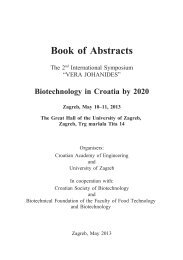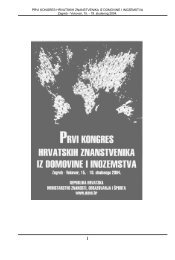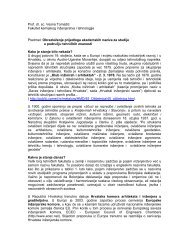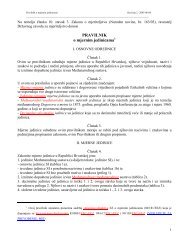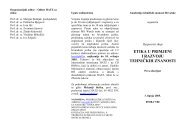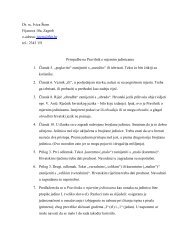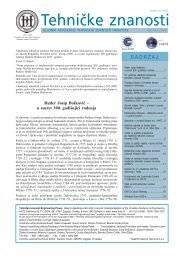annual 2010/2011 of the croatian academy of engineering - HATZ
annual 2010/2011 of the croatian academy of engineering - HATZ
annual 2010/2011 of the croatian academy of engineering - HATZ
You also want an ePaper? Increase the reach of your titles
YUMPU automatically turns print PDFs into web optimized ePapers that Google loves.
Annual <strong>2010</strong>/<strong>2011</strong> <strong>of</strong> <strong>the</strong> Croatian Academy <strong>of</strong> Engineering 29<br />
to process Spanish broom fabric. [3]<br />
During <strong>the</strong> ‘30s <strong>of</strong> <strong>the</strong> past century, foresters widely recommended <strong>the</strong> cultivation <strong>of</strong> Spanish<br />
Broom (Spartium junceum) in <strong>the</strong> coastal karst areas, more precisely M. Ani Ph. D<br />
in Forest Journal in 1937 and engineer Stane Benko in his booklet on Spanish Broom,<br />
published by <strong>the</strong> Ministry <strong>of</strong> Industry and Mining, in Zagreb, 1946. Member <strong>of</strong> <strong>the</strong> Institute<br />
for Forestry Research Ante Premuži explains <strong>the</strong> possibility <strong>of</strong> using Spanish Broom<br />
for economic purposes in his report Systematic cultivation <strong>of</strong> Spanish broom in our karst<br />
areas, published in <strong>the</strong> Forest Journal. He wrote that diverse biological properties could<br />
be put to good use for forestation <strong>of</strong> poor soil <strong>of</strong> <strong>the</strong> coastal limestone area since Spanish<br />
Broom grows on clay and limestone soil <strong>of</strong> neutral, acid and alkali reaction. Positive sides<br />
<strong>of</strong> its cultivation were highly praised, giving <strong>the</strong>se studies a more propaganda character.<br />
Alongside <strong>the</strong> coast <strong>of</strong> east Adriatic, people used and processed Spanish Broom in various<br />
ways, but it was also harvested in Istria and <strong>the</strong> coastal area <strong>of</strong> Dubrovnik in <strong>the</strong> period <strong>of</strong><br />
Austrian-Hungarian Monarchy, and later between <strong>the</strong> two World Wars. It was <strong>the</strong>n harvested<br />
by <strong>the</strong> army, tied up in bundles and exported to Italy for manufacturing military suits.<br />
There were many attempts <strong>of</strong> industrial processing in our country. Let us remember <strong>the</strong><br />
previously mentioned initiative <strong>of</strong> Rajkovi, which spread across <strong>the</strong> entire Adriatic, gaining<br />
<strong>the</strong> status <strong>of</strong> industrial processing. Immediately after <strong>the</strong> World War I in 1919, <strong>the</strong>re<br />
was an attempt in Omiš to process Spanish Broom in bulk. A factory was also built for its<br />
processing. However, <strong>the</strong> rst attempt failed since Spanish Broom had been soaked in <strong>the</strong><br />
sea for six months, <strong>the</strong>reby rotting. There were no fur<strong>the</strong>r attempts from <strong>the</strong>n on. Only<br />
after <strong>the</strong> end <strong>of</strong> World War II, Spanish Broom was rediscovered, mostly due to a shortage<br />
<strong>of</strong> textile raw material during <strong>the</strong> post-war period.<br />
The processing actually started two years after <strong>the</strong> W. W. II (1947). Around two trucks <strong>of</strong><br />
Spanish Broom, harvested near Rabac and Labin (Istria), were turned over to <strong>the</strong> district <strong>of</strong><br />
Pula to send it for processing in <strong>the</strong> factory in Fažana. It was also decided to build factories<br />
in Vodice and Zakuac near Omiš. There was a second attempt to revive <strong>the</strong> production,<br />
this time using state-<strong>of</strong>-<strong>the</strong> art methods, quite near where <strong>the</strong> rst plant had been constructed<br />
in 1919. The process <strong>of</strong> maceration was chemical, and a device for hot-air drying was<br />
used. In <strong>the</strong> paper factory in Rijeka, a department was turned into a laboratory for testing.<br />
In order to save on transport <strong>of</strong> raw material, someone suggested turning an old ship into a<br />
oating factory, which would cruise in <strong>the</strong> Adriatic and process Spanish Broom, quite expensive<br />
to harvest. The results <strong>of</strong> this test production were taken over for fur<strong>the</strong>r processing<br />
by certain spinning mills in Croatia and Slovenia, and so rst test products were actually<br />
produced. However, <strong>the</strong> process stops <strong>the</strong>re. The whole initiative, which had started positively,<br />
stopped abruptly, allegedly due to high purchasing price, and so traditional processing<br />
remained in <strong>the</strong> hands <strong>of</strong> <strong>the</strong> people. [3].<br />
There were o<strong>the</strong>r attempts to process Spanish Broom industrially. In Vodice, between 1946<br />
and 1949, a factory was built for <strong>the</strong> processing <strong>of</strong> Spanish Broom. It worked until 1954,<br />
when it was shut down due to unprotability. The same factory is scheduled for demolition<br />
today.<br />
According to former workers <strong>of</strong> <strong>the</strong> factory (Tvornica Žuke) in Vodice <strong>the</strong> technological<br />
procedure for obtaining bbers was as follows: branches <strong>of</strong> Spanish Broom with <strong>the</strong>ir<br />
shoots were soaked in sodium alkali for several days. After resting in pools with <strong>the</strong> alkali,<br />
bers would separate from <strong>the</strong> o<strong>the</strong>r parts. Bundles <strong>of</strong> Spanish Broom would be subject<br />
to water jets under pressure <strong>of</strong> four to six atmospheres. The water jets would separate b-





